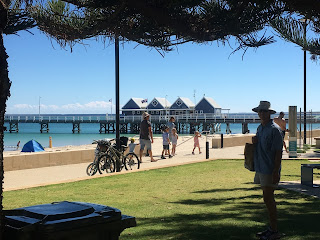 |
| Cape Leeuwin, photo from Wikipedia Where the Indian Ocean meets the Southern Ocean |
 |
| Gentle sail from Busselton Port Geographe Marina to first night's anchorage at Quindalup. Still in protected waters of Geographe Bay |
Cape Leeuwin is named after the first ship to have visited
the area, a Dutch ship in 1622. Today a grand lighthouse warns mariners with
its beacon of light that there are dangerous rocks and islets ahead. The
lighthouse was commissioned in 1896 and produces a beam of light that still can
be seen for 25 miles out to sea. The massive lens that gives focus to the light
beam floats on a ‘bed’ of liquid mercury, virtually eliminating any rotational
friction. Today the lens rotates through the power of an electric motor and the
light is generated using electricity. Until 1982 the lens was rotated by a
counterweight clockwork mechanism and the light was generated by kerosene that
the light keepers had to hoist by hand crank daily to the top of the
lighthouse.
In the modern age of navigation with GPS and electronic
charting, navigating around the cape has become much less risky than in the
days of old. What has not changed with time is the influence of the weather on
navigating these seas safely. For us this meant a long and careful eye on
weather patterns. Laurie read hours of blogs from sailors who have made that
passage to glean every bit of weather strategy she could. We spent months
studying weather models and historical weather patterns, all to improve our
odds at having a safe and pleasant sail around the capes. Predominantly, a very
strong wind blows from south to north along the coast between the two Capes.
This wind pushes against the Leeuwin current that flows south along this shore
making for a nasty sea mixed with the big swells rolling in from the Southern
Ocean. Then once you round Cape Leeuwin and the offshore islands and rocks and
sail east you will likely again face a head wind against a strong current.
 |
| Our view of Cape Leeuwin from 6 miles offshore, early evening of January 25, 2018. Finally the wind has turned southwesterly. |
It was the ‘perfect’
weather window.
As a result, we had a delightful 300-mile sail to Albany. By
the time we made landfall at Albany the evening of January 26th, the frontal system was breathing down our
backs, the air was cooling off and clouds filled the sky, spitting the first
few raindrops. Perfect timing, only wish that the weather gods were always so
accommodating, but we all know better…
The day prior to rounding Cape Naturaliste we left the
marina and anchored closer to the cape at Quindalup. At 2 a.m. the next morning
with the Southern Cross overhead we hoisted our anchor and Katmai’s sails. We sailed
northwest towards the cape in a light breeze, then rounding Cape Naturaliste with
the first rays of the sun poking over the horizon. With the sails trimmed tight
we began our sail south, first towards the southwest, then tacked back to the
southeast, then back to the southwest, back and forth we went as we made our
way south towards Cape Leeuwin. It was a lovely beat south, warm, sunny and
comfortable. As the sun settled in the west for the day the Cape Leeuwin
lighthouse stood proud and bright just to our north. We have sailed into the
Southern Ocean and the capes are behind us! It was a very good feeling.
 |
| Sailing with a following wind in the Southern Ocean |
Being in the Southern Ocean, the swells became noticeably
bigger, but with a very long period. Katmai liked that as she became a bit
livelier with an occasional surf down a wave and a slightly building breeze.
Also, very noticeable was the birdlife, lots of Shearwaters began to trail us
and even a lone Albatross stayed with us for an hour or so. Both birds are
phenomenal experts in gliding. Rarely do they beat a wing as they skim with
their wingtips inches above the waves, then rise on a wind shear only to repeat
their glide down over the waves.
 |
| 100's of shearwaters glided around us as we sailed |
As day broke the next morning, we watched their seeming
impossible flight for hours. With the new day the wind strengthened, but
remained behind us. We finally dropped the mainsail to depower the boat in the
rising breeze and continued under genoa only, still making 7 knots or better
towards Albany. As the day progressed a distinct band of clouds moved over us,
it was like a flat sheet with very sharp edges. The frontal system was not far
away, but neither was Albany and our safe-haven. With night fall we rounded
into King George Sound and were greeted by a band of bow wave riding dolphins.
 |
| Katmai in Albany Water front Marina. |
We made our way towards harbor using the
navigation beacons the commercial ships use as our guide. By 10 p.m. we coasted
into a slip in the marina and heard a kind call from a fellow sailor to throw
him our mooring lines. As we tied-off Katmai and greeted our new neighbor he
handed us the key to the marina’s hot showers. Ahhhh, a hot shower, there is
not much more enjoyable than a hot shower after a 300 mile, 44 hour sailing
journey around two notorious capes!
Now the wait begins for the next weather window to head to Tasmania. In the mean time, we are going to enjoy some sight seeing around beautiful Albany.
 |
| King George Sound from the top Mt Clarence above the city of Albany. Spectacular! |











